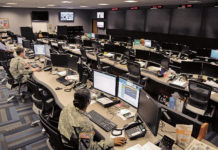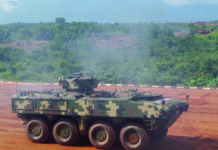The year 2020 marked a global shift in nearly all areas of our societies and the post-pandemic domino effect is still unfolding. The full-scale impact of the COVID-19 quarantine measures and lockdowns will only be visible in the long term. So far, some of its immediate effects have completely changed many of the pre-2020 paradigms, while influencing others, such as terrorist and extremist trends. After an assessment of the terrorist threat vs. COVID-19 in 2020, which appeared in the July issue, the second part of this article looks at the terrorist landscape in 2021 and the trends.
Terrorism has evolved further in a time of global crisis, highlighting visible trends that have deep roots, all of which are accentuated by the new, vulnerable security environment of 2021. While the pandemic has not been the central catalyst for any trend in the area of terrorism and counter-terrorism, it has definitely impacted directly or indirectly on many of its vital elements. While the 2020 focus has been intensively contoured around the battle against the SARS-COV-19 virus, 2021 serves to remind us that terrorism in its various forms still remains a threat to our societies.
Extremism Fuelled by Conspiracy Theories
As we have seen in various times of crisis, conspiracy theories enter the void created by upheaval and continue to be stoked by grassroots movements and authority figures. Coronavirus conspiracy theories have had devastating public health consequences, increasing uncertainty, fear and panic among the population. Conspiracy theories that have warranted the attention of homeland security also include those pushed by QAnon supporters alleging “deep state” conspiracies and more, the 5G conspiracy theories alleging that technology is used to track people and/or spread COVID and the white supremacist “Great Replacement” theory that claims there is an organised plot against whites and has been cited by mass shooters, including in Christchurch and El Paso. Most of the terrorist groups have used conspiracy theories related to the pandemic in their propaganda materials, irrespective of ideological background: this includes Salafi-jihadi, right- and left-wing groups. Each conspiracy theory used by these groups has proved to be based on the same elements, defined through separate ideological lenses.
Homegrown Extremism
Right- and left-wing terrorism have increasingly become a transnational threat that “includes everything from racially motivated violent extremists… all the way to anti-government, anti-authority violent extremists” (US Congress, 2020). For instance, the white supremacist movement has become a global trend through the believers in the “Great Replacement”: a prominent idea in the white supremacist ecosystem, which contends that the United States, Europe, and other “white” countries are being reverse-colonised, with Black, Hispanic, Arab, and other immigrants diluting the “white world”. Although the idea emerged in France, it has spread among white supremacists around the world. Salafi-jihadi extremists and white supremacists both try to appeal to grievances, hoping that potential recruits who might not otherwise join their movements could be pushed over the edge with targeted psychological propaganda.
Together with the continuous threat posed by Daesh, the last few years have seen a dramatic increase in the threat presented by both the far right and far left. As the data in the GTI highlights, there has been a 250 per cent increase in far-right terrorist incidents since 2014. In Western countries, far-right extremism now accounts for 46 per cent of attacks and 82 per cent of deaths from terrorist attacks. The US has witnessed an increased threat from homegrown terrorism not seen in a quarter-century, with right-wing extremist attacks and plots greatly eclipsing those from the far left and causing more deaths. Since 2015, right-wing extremists have been involved in 267 plots or attacks and 91 fatalities. At the same time, attacks and plots ascribed to far-left views accounted for 66 incidents leading to 19 deaths. In the coming years, we may witness more violence from domestic extremists, either by multiple members of a group or movement or lone attacks with blurred lines of ideological motivation.
Among the “three main terrorist personas”, the Salafi-jihadi groups have promoted themselves as a global brand, easy to reach and connect, unlike the far right and far left groups, who are still trying to understand and define their identities. The rise in far-right terrorism is part of a broader rise in political violence (including violent demonstrations and riots) in the West, emphasising an insight threat that has been present for a long time within our Western borders, but whose nature and identity is both hard to define and identify. As the number of terrorist attacks worldwide has decreased in recent years, worrying trends associated with the fragmentation of Daesh and the global swell of far-right and far-left terrorism and political violence suggest that, when it comes to terrorism, it is important to maintain strategic-policy focus. While the political, social, and economic pressures may be great, concerted and ongoing efforts to address terrorism trends based on empirical data and local experience are nothing short of essential in 2021 and beyond if we are to continue this five-year downward trend in terrorism worldwide.
Simple vs. Complex Attacks
In September 2020, the FBI Director Christopher Wray told the US Congress that the greatest threat to the homeland “is not one organisation, certainly not one ideology, but rather lone actors, largely self-radicalised online, who pursue soft targets using readily accessible weapons.” Most of the terrorist attacks witnessed in Europe in recent years have proved his words to be true. Still, as the pandemic unfolds and the opportunities arise, many have started to wonder how the next complex terrorist attack will take place. Bearing in mind the symbiosis of the “trinity of terrorism” that has only been seen with the propaganda so far, there is one slight possibility for those groups to share more than radicalisation tools. Although hard to imagine, the lines between ideologies become blurred when it comes to common practical interests and 2021 could bring complete shifts in strategy and practice of terrorist attacks. Among Salafi-jihadi groups, the complex coordinated attacks in Paris, Mumbai and Sri Lanka are recycled in propaganda and recruitment materials as the gold standard of attacks. Individual operations have been encouraged by both Daesh and al-Qaeda as they have acknowledged that their homegrown loyalists in the West and other target regions aren’t always the brightest bulbs and may be less likely to catch the attention of law enforcement in the planning stages by working alone. Encouragement of lone operations can also lead to more opportunistic attacks and can give freedom to low-skilled terrorists to use simple weapons and tactics to the best of their abilities. But these groups are also aching for a fresh complex coordinated attack as an ideal recruitment and propaganda boost as they evolve and grasp at new opportunities.
In the case of Salafi-jihadi groups such as Daesh, any of the former terrorist fighters who have travelled from the conflict zone and managed to disappear have the potential to organise a complex attack due to their training and battleground experience gathered in Syria and Iraq.
The Next Salafi-Jihadi Generation
Though Daesh lost its caliphate, it is already famous for its amazing capacity to evolve and expand even during the most challenging of times. The virtual caliphate – a chimera of the physical one – is continuously building the network of supporters and recruiters, ultimately posing a greater threat in the long term than the one defeated in Syria and Iraq. Through the online space, the groups recruit, inspire, and teach homegrown violent extremists anywhere in the world, while sending threatening messages to prove their resilience. Although many have rushed to declare victory against the groups, Daesh has proved once again that its ashes are its main strength. Its provinces are still active, particularly through attacks in West Africa and Afghanistan. More importantly, they have laid down a framework of borderless jihad and a blueprint for growing a terror movement both on the dark web and the open internet that is impossible to rein in. And while COVID-19 hasn’t left their own ranks untouched, the virus has had the group thinking more about bioweapons and unconventional attacks as we look ahead.
Similarly, the Taliban and their relation to both al-Qaeda and Daesh highlight a complex network of common interest and calculated strategies. Terrorists no longer live, communicate, or recruit in silos: a victory against a common enemy is viewed at its core a victory for all, and that is feeding the ever-growing and accessible ideological marketplace of terrorist ideas, methods and inspiration – in addition to the physical assistance the Taliban and their terror allies share. Jihadist groups have developed effective and sophisticated communication strategies via the creation of magazines and weeklies such as Dabiq / Dar al Islam / Rumiyah / al Naba’ (ISIS) and Inspire / one Ummah (Al Qaeda), but mainly via social media channels such as Facebook, Twitter, Telegram, Instagram, Rocketchat, Tam Tam and Riot. Jihadist groups’ online strategy – the “cyber-jihad”- is perceived by terrorism experts as the perfect reflection of terrorists’ core interests: their ability to communicate on logistical and operational issues as well as their survival capacity through the spreading of their radical propaganda and the recruitment of new adherents or sympathisers. Therefore, the propaganda strategies of those groups have a dual effect: they serve both as a tool for terrorist movements to enforce their belief system on potential recruits and as a means to signal alternative forms of legitimacy and distinguish themselves from rival movements.
While Daesh-core has experienced a significant decline in capability and loss of territory, it is not defeated. One mistake could bring us back to the 2007 “Anbar Awakening” in Iraq. Back then, the international scene witnessed the ability of the Islamic State in Iraq (ISI), as it was called then, to rebuild itself and reach even greater heights. ISI’s strategy is based on a staged approach—not dissimilar from the Maoist strategy of protracted warfare—and after their defeat in the “Anbar Awakening” they simply returned to a lower stage, went underground and re-grouped in the countryside. They expect to oscillate between stages before eventual victory. It is important to remember that it is this strategy that is arguably its primary export to global affiliates. If we repeat the same mistakes, the already built Daesh brand is more than capable of re-emerging and rising in strength once again.
The Lost Soldiers of a Fake Caliphate
Ten years ago, the Syrian civil war represented the perfect storm to be manipulated by the terrorist groups that have threatened the region for a long while. Today, thousands of family members of Daesh fighters, mainly women and children, are kept in refugee camps and prisons in Syria and Iraq, with some serving their sentences in their home countries, and hundreds more militants have been hiding from justice around the world. The Arab Spring started with hope but turned into a fiasco, leaving behind a perfect “time-bomb” with two shells: the current generation of Salafi-jihadi that disappeared out of the war zone and the next generation of Salafi-jihadi that is now forming in the refugee camps and prisons in Syria and Iraq. Both shells of the “time-bomb” are equally dangerous and can serve the terrorist purpose in both the short and long term.
According to several official reports and open sources, the Security Service of Ukraine (SBU) stated that they had uncovered a sleeper cell of Daesh militants hiding in Kyiv, accusing them of conducting underground activities. Ukrainian Security Services also mentioned that the leader of this cell was a citizen of an Eastern European country who had participated in the Syrian war. In 2019, he arrived in Ukraine with fake documents and gathered a group of like-minded foreigners, with the goal of returning to Syria to participate in a new war on the side of Daesh. Ukraine long ago became a destination for Daesh militants fleeing the wars in Syria and Iraq. At the end of 2019, Caesar Tokhosashvili, a Georgian citizen, was arrested in Kyiv. He was one of the deputies of Daesh’s so-called “Minister of War”, Umar Shishani, and a comrade of the leader of the Daesh secret police (“Amnia”) – a Chechen native, Akhmed Chatayev. Tokhosashvili faked his death in late 2017, fleeing first to Turkey before settling in a small town near Kyiv. His escape strategy proved so efficient that he had even set up a small business at the local market. Unfortunately, he is not the only one who managed to go underground and wait for the next mission. The number of Daesh members hiding underground around the world is hard to estimate. In the case of Ukraine, according to various sources, the country is currently playing unwilling host to anywhere from 50 to several hundred militants who fought for the Islamic State. Ukraine has also represented the perfect destination for many Westerners who joined right or left-wing groups and travelled and fought in the Syrian war first. Just like the sleeping cell denounced by the Ukrainian Security Services a few months ago, hundreds of similar terrorist groups related to Daesh might have made their way out of the Syrian conflict. In the same way, dangerous foreign terrorist fighters with Western backgrounds have also left Syria, while believed to be deceased by the authorities, thereby making their way to an underground life.
An example of one such case is Thomas-Marcel Christen, also known by the name Abu Musab al-Almani. In 2015, a Daesh cell killed hundreds in Paris and Brussels, while the identity of their instructor, Thomas-Marcel Christen, was kept secret for a long time. A Swiss-German convert, originally from Aargau, Christen came from a separated family. He lived with his father at a campsite in France for several months in 1998, before his mother took him back to Switzerland and then moved with him to Frankfurt in 2006. Christen often visited Frankfurt’s Abu Bakr mosque where he converted to Islam in 2009. This is the place where he is known to have met the radical Moroccan-German preacher Said Emrani, aka Abu Dujana, for the first time, whose sermons pushed him towards radicalisation. After moving to Bonn, Christen married a close relative of Abu Dujana, with whom he had a daughter. In March 2013, he travelled from Cologne to Paris and then to Istanbul, taking with him cellphones, laptops and €15,000. Christen – Abu Musab al-Almani – quickly rose within the Daesh ranks, reaching the rank of Head of the Amniyat Unit in Manbij in 2014. He made himself known for his commitment to the cause and for the language skills that helped him instruct and direct wider networks: German, English, French, Arabic and reportedly also some Russian. Unlike other foreign fighters who posed with guns and black Daesh flags, Christen was very strict in regard to footage of himself: he never posted pictures and would confiscate cellphones when he suspected that someone had taken a photo of him.
Christen reached even higher ranks and got to know Abu Mohammed al-Adnani, Daesh’s official spokesperson, a veteran of the organisation since 2003 and one of its most senior leaders. He reportedly married a close relative of al-Adnani, ensuring personal ties to the core leadership of the group. Al-Adnani was also head of Daesh Amniyat and its external operations. While most Daesh attacks worldwide have been executed by supporters who might have been instructed via messengers, Daesh also trained attackers in Syria for much more sophisticated attacks. Christen soon became a key player within this branch and assumed the rank of Amir for his own special unit, Katiba Furqan. The unit was based in Raqqa and had between 50 and 100 members whom he trained for terror attacks abroad.
On 13 November 2015, a suicide bomber blew himself up outside the Stade de France stadium during a football match. Soon after, several other attacks took place in bars and cafés, killing people with military precision. The attackers were equipped with assault rifles which they used in single fire mode, murdering their victims with great precision. More than three dozen people were killed in bars, restaurants and open streets. Further on, Daesh terrorists Foued Mohamed-Aggad, Ismail Omar Mostefai and Samy Amimour stormed the Bataclan hall where the American rock band Eagles of Death Metal were playing. The attackers murdered 89 people with assault rifles and explosive devices. The ringleader, Abdelhamid Abaaoud, managed to escape and was killed in a raid five days later. Salah Abdeslam, the only survivor of the terrorist cell, escaped to Belgium where he joined the rest of the Paris-Brussels Daesh terror network.
The attack represents the most significant Daesh external operation to date. The French Government declared a state of emergency, and thousands of soldiers were deployed throughout the country. While many names within the Daesh network were pointed out during the investigation, the name of the key member did not show up: Thomas-Marcel Christen. Authorities knew his Daesh name – Abu Musab al-Almani – but were unsure about the elusive person hiding behind it – who wasn’t a German national, but a Swiss. The lack of pictures and videos of Christen made the work that much harder for the authorities. He also broke off all contact with family back in 2013.
Later, in January 2016, a video released by al-Hayat presented new footage of the Paris attackers. The footage shows the Paris attackers dressed in combat gear shooting and decapitating prisoners most likely somewhere in Syria. Among them were the Bataclan attackers. But there was also one short sequence which shows one of the Paris attackers during a live fire exercise, localised most probably at an abandoned military base in the vicinity of Raqqa/Tabqa. The attacker was identified as Brahim Abdelslam, aka Abu Qaqa al-Baljiki, who later shot people in bars and restaurants and finally blew himself up in the Comptoir Voltaire café. During the combat exercise, an instructor can briefly be seen pushing Abdelslam during the shooting, to train him to keep focused on his targets even in a panicked crowd. The mysterious instructor is seen to be wearing combat gear and a balaclava, but he was also pixelated by Daesh media to make his identification even harder to ascertain. The pixelated trainer we can see in this short sequence was later identified as Thomas-Marcel Christen, the elusive instructor of the Paris attackers.
As authorities moved forward with the investigation, suicide bombers attacked Brussels airport and a metro station, killing 32. At least two members of the cell were trained in Syria beforehand. After the Brussels attack, Daesh al-Hayat media outlet released another video which includes the same sequence of Abdeslam during his training with Christen, but this time the Paris attacker can be heard speaking. The video goes on to show the training sequence with Christen again, but then also showing scenes of the Brussels attack and Brussels cell members Najim Laachraoui and Mohamed Belkaid who wear the same combat gear as the Paris attackers and were also instructed by Christen.
The deadly attacks in Paris and Brussels were also a further career boost for Thomas-Marcel Christen within the ranks of the Amniyat. He was promoted and became the overall Daesh ExOps commander for the whole European theatre, subordinate only to Abu Mohammed al-Adnani. Although extremely dangerous and well-trained, Christen’s location is currently unknown to the authorities. And he is just one of the many fighters who managed to escape underground before the defeat of the fake caliphate.
Conclusion
The COVID-19 pandemic has shifted much of our attention to various different areas of our societies but has not reduced any of the previous threats. Although indirectly impacted by some of the pandemic’s side-effects, terrorism remains a pressing global issue that has developed dangerous trends, mostly visible in 2021: conspiracies, homegrown extremism, rise of far right and far left extremism, threat of complex terrorist attacks and the Salafi-jihadi return.












